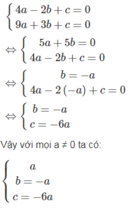Hãy nhập câu hỏi của bạn vào đây, nếu là tài khoản VIP, bạn sẽ được ưu tiên trả lời.

x = -2 là nghiệm của phương trình: a x 2 + bx + c = 0, ta có:
4a - 2b + c = 0
x = 3 là nghiệm của phương trình: a x 2 + bx + c = 0 ta có:
9a + 3b + c = 0
Ba số a, b, c là nghiệm của hệ phương trình:

thì phương trình a x 2 + bx + c = 0 có nghiệm x 1 = -2; x 2 = 3
Ví dụ: a = 2, b = -2, c = -12 ta có phương trình:
2 x 2 - 2x - 12 = 0
⇒ x 2 - x - 6 = 0
⇒ (x + 2)(x - 3) = 0
Có nghiệm: x 1 = - 2; x 2 = 3
Có vô số bộ ba a, b, c thỏa mãn yêu cầu bài toán.

Giả sử pt: \(x^2+bx+c=0\) có 2 nghiệm phân biệt \(x_1;x_2\) thỏa mãn đề bài.
Theo hệ thức Vi - ét ta có: \(x_1+x_2=-b\) và \(x_1x_2=c\)
Kết hợp với giải thiết ta có: \(x_1=x^2_2+x_2\) và \(b+c=4\)
\(\Leftrightarrow x_1x_2-\left(x_1+x_2\right)=4\)
\(\Leftrightarrow x^3_2-2x_2-4=0\)
\(\Leftrightarrow\left(x_2-2\right)\left(x^2_2+2x_2+2\right)=0\)
\(\Leftrightarrow x_2=2\)(Vì: \(x^2_2+2x_2+2=\left(x_2+1\right)^2+1>0\))
Khi đó ta có: \(x_1=4+2=6\Rightarrow b=-8\)và \(c=12\)
Thử lại với \(b=-8;c=12\)ta được pt sau:
\(x^2-8x+12=0\)
\(\Leftrightarrow x_1=6;x_2=2\)(Thỏa mãn yêu cầu bài toán)
Vậy \(\left(b,c\right)=\left(-8;12\right)\) là cặp cần tìm.

Theo Vi et ta có: \(\hept{\begin{cases}x_1+x_2=\frac{-b}{a}\\x_1x_2=\frac{c}{a}\end{cases}}\)
Theo giả thuyết thì:
\(x_1^2+x_2^2=2x_1x_2\)
\(\Leftrightarrow\left(x_1+x_2\right)^2-4x_1x_2=0\)
\(\Leftrightarrow\frac{b^2}{a^2}-\frac{4c}{a}=0\)
\(\Leftrightarrow b^2-4ac=0\)
Vậy ta có ĐPCM

\(x^2+ax+b+1=0\)
\(\Delta=a^2-4b-4\)
Để pt có 2 nghiệm pb \(\Leftrightarrow\Delta>0\Leftrightarrow a^2-4b-4>0\)
Theo hệ thức Vi-et ta có: \(\hept{\begin{cases}x_1+x_2=-a\\x_1.x_2=b+1\end{cases}}\)
Ta có: \(\hept{\begin{cases}x_1-x_2=3\\x_1^3-x_2^3=9\end{cases}}\)
\(\Leftrightarrow\hept{\begin{cases}x_1-x_2=3\\\left(x_1-x_2\right)\left(x_1^2+x_1x_2+x_2^2\right)=9\end{cases}}\)
\(\Leftrightarrow\hept{\begin{cases}x_1-x_2=3\\x_1^2+x_1x_2+x_2^2=3\end{cases}}\)
\(\Leftrightarrow\hept{\begin{cases}x_1-x_2=3\\\left(x_1-x_2\right)^2+3x_1x_2=3\end{cases}}\)
\(\Leftrightarrow\hept{\begin{cases}x_1-x_2=3\\x_1x_2=-2\end{cases}}\)
\(\Leftrightarrow\hept{\begin{cases}x_1=3+x_2\\\left(3+x_2\right)x_2=-2\left(1\right)\end{cases}}\)
\(\left(1\right)\Leftrightarrow x_2^2+3x_2+2=0\)
\(\Delta=1\)
\(\Rightarrow\)pt có 2 nghiệm pb \(\orbr{\begin{cases}x_2=\frac{-3+1}{2}=-1\Rightarrow x_1=2\\x_2=\frac{-3-1}{2}=-2\Rightarrow x_1=1\end{cases}}\)
TH1: \(x_1=2;x_2=-1\)
\(\Rightarrow\hept{\begin{cases}a=-1\\b=-3\end{cases}}\)( LOẠI vì a^2 -4b-4 <0 )
TH2: \(x_1=1;x_2=-2\)
\(\Rightarrow\hept{\begin{cases}a=1\\b=-3\end{cases}}\)( tm )
VẬY ...

- \(\Delta^'=m^2-\left(m-1\right)\left(m+1\right)=m^2-m^2+1=1>0\)vậy phương trình luôn có hai nghiệm với mọi \(m\ne1\)
- Theo viet ta có : \(\hept{\begin{cases}x_1+x_2=2m\\x_1x_2=m+1\end{cases}}\)\(\Rightarrow m+1=5\Rightarrow m=4\Rightarrow x_1+x_2=2m=2.4=8\)
- từ hệ thức viet ta khử m được hệ thức liên hệ giữa 2 nghiệm ko phụ thuộc m: thấy \(x_1+x_2-2x_2x_1=2m-2\left(m+1\right)=-2\)
- \(\frac{x_1}{x_2}+\frac{x_2}{x_1}=-\frac{5}{2}\Leftrightarrow\frac{x_1^2+x_2^2}{x_1x_2}=-\frac{5}{2}\Leftrightarrow\frac{\left(x_1+x_2\right)^2-2x_1x_2}{x_1x_2}=-\frac{5}{2}\)\(\Leftrightarrow\frac{4m^2-2m-2}{m+1}=-\frac{5}{2}\Rightarrow8m^2-4m-4=-5m-5\left(m\ne-1\right)\)\(\Leftrightarrow8m^2+m+1=0\left(vn\right)\)không có giá trị nào của m thỏa mãn

a: \(\left\{{}\begin{matrix}x_1+x_2=-b\\x_1x_2=c\end{matrix}\right.\Leftrightarrow\left\{{}\begin{matrix}b=10\\c=-24\end{matrix}\right.\)
b: \(\left\{{}\begin{matrix}x_1+x_2=-b\\x_1x_2=c\end{matrix}\right.\Leftrightarrow\left\{{}\begin{matrix}-b=-5\\c=0\end{matrix}\right.\Leftrightarrow\left\{{}\begin{matrix}b=5\\c=0\end{matrix}\right.\)
c: \(\left\{{}\begin{matrix}x_1+x_2=2\\x_1x_2=1-2=-1\end{matrix}\right.\Leftrightarrow\left\{{}\begin{matrix}b=-2\\c=-1\end{matrix}\right.\)
d: \(\left\{{}\begin{matrix}x_1+x_2=3-\dfrac{1}{2}=\dfrac{5}{2}\\x_1x_2=-\dfrac{3}{2}\end{matrix}\right.\Leftrightarrow\left\{{}\begin{matrix}b=-\dfrac{5}{2}\\c=-\dfrac{3}{2}\end{matrix}\right.\)

a) \(x_1^2+x_2^2=23\)
\(\Leftrightarrow x_1^2+2x_1x_2+x_2^2-2x_1x_2=23\)
\(\Leftrightarrow\left(x_1+x_2\right)^2-2x_1x_2=23\)
\(\Leftrightarrow5^2-2\left(m+4\right)=23\)
<=> m=-3
b) \(x_1^3+x_2^3=35\)
\(\Leftrightarrow\left(x_1+x_2\right)\left(x_1^2+x_1x_2+x_2^2\right)=35\)
\(\Leftrightarrow\left(x_1+x_2\right)\left[\left(x_1+x_2\right)^2-3x_1x_2\right]=35\)
\(\Leftrightarrow5\left[5^2-3\left(m+4\right)\right]=35\)
<=> m=2
c) \(\left|x_2-x_1\right|=3\)
\(\Leftrightarrow\left(\left|x_2-x_1\right|\right)^2=3^2\)
\(\Leftrightarrow x_1^2-2x_1x_2+x_1^2=3^2\)
\(\Leftrightarrow\left(x_1+x_2\right)^2-4x_1x_2=9\)
<=> m=0
ĐK để pt có hai nghiệm phân biệt là: \(\Delta>0\Leftrightarrow25-4\left(m+4\right)>0\Leftrightarrow m< \frac{9}{4}\) ( @@)
Gọi \(x_1;x_2\) là hai nghiệm của phương trình
Theo định lí Viet ta có: \(x_1+x_2=5;x_1.x_2=m+4\)
a) \(x_1^2+x_2^2=23\)
<=> \(x_1^2+x_2^2+2x_1x_2=23+2x_1x_2\)
<=> \(\left(x_1+x_2\right)^2=23+2x_1x_2\)
=> \(25=23+2\left(m+4\right)\)
<=>m = -3 ( thỏa mãn @@)
b) \(x_1^3+x_2^3=35\)
<=> \(\left(x_1+x_2\right)^3-3\left(x_1+x_2\right)x_1x_2=35\)
=> \(5^3-3.5.\left(m+4\right)=35\)
<=> m = 2 ( thỏa mãn @@)
c) \(\left|x_2-x_1\right|=3\)
<=> \(\left(x_1-x_2\right)^2=9\)
<=> \(\left(x_1+x_2\right)^2-4x_1x_2=9\)
=> \(5^2-4\left(m+4\right)=9\)
<=> m = 0 ( thỏa mãn @@)
giải phương trình x2 - 4x + 4 =7/2
x = -2 là nghiệm của phương trình: a x 2 + bx + c = 0, ta có:
4a - 2b + c = 0
x = 3 là nghiệm của phương trình: a x 2 + bx + c = 0 ta có:
9a + 3b + c = 0
Ba số a, b, c là nghiệm của hệ phương trình